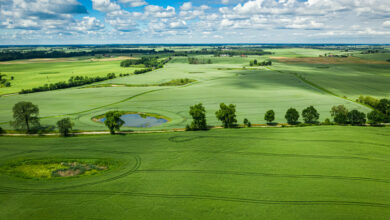Subtraction and addition accounts always with negative results
If it is true that we cannot stop development and prevent a country from keeping up with its population growth, it is also an unquestionable truth that nature has already clearly shown us the consequences of the lack of respect that human beings have shown for its preservation. Climate change is now evident, and we all have an obligation to contribute so that the environmental situation does not worsen further. This explains, to a great extent, the stance of nature defenders against the Doug Ford government’s Bill 23, which removes 7400 acres of the Greenbelt, in order to give them to housing construction.
Phil Pothen is the Ontario Environment Program Manager for Environmental Defence, one of the most active environmental associations in the fight against what they consider to be an attack on the environment and nature, and it was he who explained to us the reasons for ED’s frontal opposition to the changes that Ford is proposing/implementing for what is the world’s largest environmental protection zone, which was designed to protect farmland, forests, wetlands, rivers and lakes. Doug Ford has announced that he intends to remove 7,400 hectares from 15 different zones, justifying this action by the need to build around 50,000 houses. However, he says that 9,400 hectares of green space will be added elsewhere. Subtracting and adding up accounts which, for environmental defenders, always have negative results.
 Milénio Stadium: Briefly, can you explain why Environmental Defence is opposed to Ford’s plan to free up Greenbelt land for construction projects?
Milénio Stadium: Briefly, can you explain why Environmental Defence is opposed to Ford’s plan to free up Greenbelt land for construction projects?
Phil Pothen: The Ontario government’s push to divert construction into the Greenbelt is a recipe for building fewer and more expensive homes, while destroying some of Ontario’s rarest wildlife habitats and what remains of Canada’s high-quality farmland.
While Canada looks huge on a map, only a tiny part of it is any good for agriculture, and only miniscule slivers of that are actually high-quality (“class 1” or “class 2”) farmland that can grow the full range of food we need. Those minute slivers correspond almost precisely with the surroundings of Ontario’s biggest cities and suburbs – and with the habitat of our most endangered species.
Without the Greenbelt as a hard and permanent barrier to suburbs, sprawling further into that narrow strip of farmable countryside would jeopardize Canada’s food security – and ecological integrity.
MS: The provincial government’s main argument is based on the extreme need for housing, not only for those who already live in the province but mainly to accommodate the immigrants that Ontario hopes to welcome in the near future. What can you say about this?
PP: It is appalling to see this government exploit the very real and very severe shortages of housing in the neighbourhoods where Ontarians want to live as an excuse for policies that it KNOWS will make the problem worse.
Our housing shortage has absolutely nothing to do with any shortage of land to build on. Long before the Greenbelt removals, Ontario already had vastly more farmland around GTHA towns and cities designated for development, but sitting unused, than we will ever need to build housing – more than 350km2! Even without the Greenbelt removals, that existing glut had been increased to 590km2.
We have a housing shortage because, for many decades, we have been squandering a scarce and constrained supply of construction labour, equipment and other inputs on building the most wasteful and expensive forms of housing (large, single-detached houses and highrises in downtowns) in the places where it is most inefficient to build them (unserviced farmland where a large share of the work gets wasted on brand new roads, sewers, and other infrastructure). While the average size of a new house in the 1970s was roughly 1050sf, a new house in Mississauga is nearly 4000sf on average.
The only way to fix our housing shortage quickly is to ensure that the same amount of labour and materials creates a larger number of homes by concentrating construction on building large numbers of modest family sized homes (1000-12000sf) in EXISTING post-WWII neighborhoods or where roads and sewers are already in place. Houses also need to be built in more affordable formats, such as wood-frame, mid-rise family apartment buildings, typical of Europe.
By diverting scarce construction resources to wasteful Greenbelt subdivision, the Ontario government is taking it AWAY from more efficient, shovel-ready developments like Pickering’s Seaton Community and Toronto’s family-sized multiplex apartment plans. They’re making it HARDER to increase housing supply fast.
MS: There are also those who say that the Greenbelt is a too vast area and that a lot of the land doesn’t produce anything relevant, it’s just cultivated to prevent its owners from being taxed, and so between having empty land that’s not useful and building houses on it… there are those who say they prefer the houses. What do you think of this kind of statement?
PP: Every inch of the Greenbelt is precious and vital. The Greenbelt represents only a fraction of the land mass that is required to feed Canada’s population and sustain its southern wildlife species.
As has long been the case in many parts of Europe, a lot of southern Ontario’s quality farmland is now held by agricultural landlords and farmed by tenant farmers. That’s still compatible with farming food crops using agricultural practices that improve the land, but only if we give the tenant farmers certainty that it will never be legal to develop the land for anything other than agriculture. That’s precisely the certainty that the Greenbelt provides.
The problem arises when land isn’t protected by the Greenbelt – or when the government creates the impression that land that’s in the Greenbelt now might be removed in the future. In those cases, farmers are deprived of the CERTAINTY and PERMANENCE they need to manage the land properly. They have to resort to short-term cash cropping that can degrade the soil and damage nearby habitat. It’s the ABSENCE of Greenbelt protection or the threat it might be removed that causes land to be underutilized agriculturally.
As for wanting houses – as mentioned above – spreading our scarce construction over a larger land area makes it slower, less efficient and more expensive, resulting in fewer homes.
MS: On the other hand, what kind of construction will take place on the land released from the Greenbelt? Will it be affordable housing?
PP: It’s unlikely that developing Greenbelt land would ever result in any net new homes. This would only divert construction from existing neigbourhoods, and away from other “greenfield” areas that are already serviced and ready to build.
Because Greenbelt land is situated in places where roads, sewers, schools, and other infrastructure would have to be built from scratch, and at densities too low to support frequent, reliable transit, there’s simply no possibility of these areas becoming places where it is affordable for ordinary people to live.
As an aside, car-dependent Greenbelt suburbs are not the kind of places where the vast majority of GTHA and Golden Horseshoe residents say they want to live. The vast majority of residents would much prefer to live in a place where they can conveniently get groceries, get to school or travel to work without relying on cars.
MS: Is the situation already irreversible, in your opinion? Is the Greenbelt really going to change shape?
PP: The great news is that the Greenbelt removals can be reversed, right now, with the stroke of a pen. None of the farmland seems to have been destroyed yet. Even if the current government doesn’t see sense and undo this decision, we expect that Federal impact assessment will prevent any destruction within the next couple of years, and a subsequent government will reverse the Greenbelt removals.
Madalena Balça/MS









Redes Sociais - Comentários